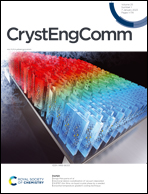Supercapacitive study for electrode materials around the framework-collapse point of a Ni-based coordination polymer†
Abstract
A coordination polymer precursor, namely Ni-TATB, has been synthesized from 4,4′,4′′-s-triazine-2,4,6-triyl-tribenzoate (H3TATB) as a tripodal ligand and nickel acetate providing nickel metal nodes. According to the thermogravimetric curve, Ni-TATB is calcined at four temperatures of 300 °C, 365 °C, 375 °C and 400 °C around the collapse point (370 °C), and the corresponding products are obtained, namely, Ni-TATB-300, Ni-TATB-365, Ni-TATB-375 and Ni-TATB-400, respectively. The characterization results show that below 370 °C, with the increase of the calcination temperature, the Ni-TATB skeleton structure will be retained, and more Ni(II) species are exposed on the surface, resulting in the improvement of the electrochemical performance. However, the calcination temperature selected above 370 °C will destroy the framework structure of MOFs and reduce Ni(II) to Ni(0), resulting in a significant decrease in the performance. Electrochemical performance tests show that the Ni-TATB-365 electrode exhibits a maximum specific capacity of 294.5 C g−1 at a current density of 1.0 A g−1, superior to the other electrodes, suggesting that high-temperature activation while maintaining the framework architecture of the coordination polymer can effectively enhance the final performance. Additionally, the asymmetric supercapacitors, which consist of activated carbon (AC) and a Ni-TATB-365 device, Ni-TATB-365//AC, deliver a higher energy density of 24.44 W h kg−1, superior cycling stability and practical applications in powering LEDs.



 Please wait while we load your content...
Please wait while we load your content...